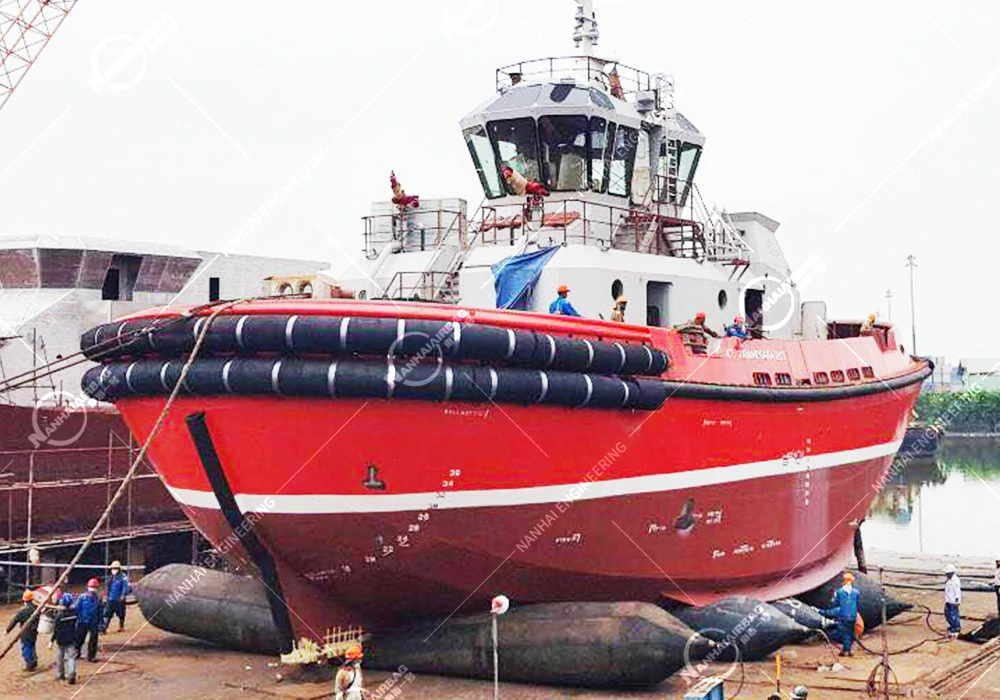W-Rubber Fenders: The Secret Weapon for Smarter Marine Protection
08/07/2025Square Rubber Fenders: The Unseen Heroes Keeping Ports Safe, Ships Intact, and Money in Your Pocket
15/07/2025

Ever watched a massive cargo ship inch its way off a dry dock, only to get stuck halfway because the crane malfunctioned? Or a small fishing boat’s hull crack under the strain of a hydraulic lift? Those disasters aren’t just dramatic—they’re expensive. Enter ship lifting airbags: the unsung heroes of modern shipyards, turning risky, multi-day launches into smooth, hour-long operations. Let’s dive into why these rubbery cylinders are becoming the go-to for launching (and lifting) vessels of every size.
What Are Ship Lifting Airbags?
Ship lifting airbags are large, cylindrical rubber devices filled with compressed air, designed to lift, move, or launch ships by distributing weight evenly across their flexible surface. Shaped like giant sausages (but way sturdier), they’re typically made from layers of synthetic rubber (like neoprene or EPDM) reinforced with steel wires or fabric for strength. Unlike cranes or hydraulic jacks, they conform to uneven surfaces—whether a dusty slipway, a rocky beach, or a sloped dock—making them incredibly versatile.
Why This Matters: When a Failed Launch Costs Millions (and Derails Lives)
Imagine a small coastal shipyard spending 6 months and $500k building a new fishing trawler. Launch day arrives, the crane breaks down, and the trawler sits stuck on the slipway for weeks. The owner loses contracts, workers sit idle, and the hull cracks from prolonged pressure—all because they relied on outdated equipment.
The Hidden Risks of Traditional Launch Methods
- Crane Failures: Cranes are expensive to rent, require skilled operators, and can drop loads (a single mistake can total a ship). In 2021, a crane collapse in Indonesia damaged a $2M ferry during launch, delaying its maiden voyage by 4 months.
- Hydraulic Limitations: Hydraulic jacks need flat, stable ground—and even then, they struggle with large vessels. A 2023 report found that 30% of hydraulic launches fail due to uneven surfaces, costing ports an average of $150k per incident.
- Hull Damage: Rigid lifts put pressure on weak points (like welds or bulkheads), leading to cracks or dents. Repairing a damaged hull post-launch? That’s another 50k–100k in repairs.
Ship lifting airbags eliminate these headaches. In Vietnam, a family-owned shipyard used airbags to launch a 50m ferry without a single crane—and did it in 3 hours instead of 3 days. Meanwhile, a U.S. port saved $200k by using airbags to reposition a stuck cargo ship instead of hiring a specialized tugboat.
How Do Ship Lifting Airbags Work? The “Soft Power” Revolution
These aren’t your average inflatable pool toys. Ship lifting airbags are engineering marvels built to handle extreme weight:
1. Inflatable Flexibility = Adaptability
Airbags adjust to the shape of the ship’s hull, whether it’s curved, angled, or uneven. This eliminates stress points—unlike cranes, which focus weight on a single hook or jack.
2. High Load Capacity = Heavy-Duty Performance
A single 2m-diameter airbag can lift up to 50 tons. Stack them side by side, and they can handle 1,000-ton ships. Even better: they deflate quickly for easy repositioning.
3. Durability = Longevity
Made with layers of abrasion-resistant rubber, airbags last 5–10 years—even in harsh conditions (saltwater, UV rays, or rocky shores). Cheaper alternatives tear after 1–2 uses, but top-quality bags keep working.
Why Ship Lifting Airbags Beat Cranes, Hydraulics, and Other “Solutions”
Traditional methods have their place, but airbags are rewriting the rules. Here’s why:
1. No Heavy Equipment Needed
Forget renting million-dollar cranes or hiring specialized crews. Airbags weigh just 100–200kg each and can be moved by hand (or a small truck). Small shipyards, remote docks, or DIY enthusiasts can now launch large vessels independently.
2. Safer for Hulls and Crews
Airbags distribute weight evenly, so there’s no risk of cracking welds or crushing bulkheads. Crews don’t need to climb underneath unstable loads—just inflate, position, and let physics do the work.
3. Works Everywhere
Stuck on a slope? Rocky beach? Tidal inlet? Airbags conform to any terrain. They’re even used in flood zones to reposition stranded boats without risking lives.
4. Cost-Effective Long-Term
Sure, airbags cost more upfront than a basic jack. But with no crane rentals, no crew fees, and fewer repairs, most shipyards save 30–50% on launch costs within a year.
People Also Ask: Your Top Questions About Ship Lifting Airbags
Q: Are ship lifting airbags safe for delicate hulls?
A: Absolutely. Their flexible design prevents concentrated pressure, so even fragile fiberglass or aluminum hulls stay scratch-free. Many yards use them for vintage or custom-built boats.
Q: How big do they need to be for my ship?
A: It depends on the vessel’s weight and hull shape. A 10m fishing boat might need 2–3 airbags (2m diameter each), while a 500-ton cargo ship could require 10+ larger bags (3m+ diameter). Manufacturers often provide free size calculators.
Q: Can they be reused?
A: Yes—top-quality airbags are designed for 500+ launches. Just deflate, clean, and store them (they fold up to save space).
Q: Do they work in bad weather?
A: They handle wind, rain, and even light waves. Avoid launching in extreme storms, but airbags are far more reliable than cranes in tricky conditions.
Q: Are they better than marine fenders or rubber fenders?
A: They serve different purposes. Marine fenders (including rubber fenders) protect docks during berthing, while ship lifting airbags focus on lifting/launching. Both use durable rubber, but their designs and uses are distinct.
Final Thoughts: Don’t Let Old-School Methods Sink Your Launch
In shipping, time is money—and a failed launch can derail both. Ship lifting airbags aren’t just a “nice-to-have”; they’re the difference between a smooth, profitable launch and a costly disaster.
Ready to upgrade? Start by reaching out to trusted marine equipment suppliers (look for those specializing in marine airbags)—they’ll help you size, test, and deploy your first set. Your hull, your crew, and your bottom line will thank you.
